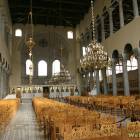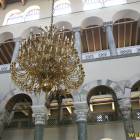How did the first Christian churches look like
There are such lucky towns that offer their visitors the opportunity of time traveling. For instance, when I entered the Byzantine Art Museum in Thessaloniki, I was met by a large print with what seemed to be a drawing after a crossing between an ancient temple and a modern church. While looking at that wall-size image, I was thinking that that’s probably how the early Christian churches looked like, and felt sorry you cannot see something like that anymore. Little did I know that just some hours later, I was to enter an unsuspecting humble construction, to find myself inside a marvelous place of worship that was exactly like the print in the museum. I was overwhelmed by joy and felt privileged by such an opportunity.
The first places of worship used by Christians were, of course, not special buildings. Any private house, offered temporarily by a believer, was good enough. Though the conversion of Constantine, and his Edict of Tolerance was important and is usually presented as decisive in history books, we should not forget the explosive spread of this faith. In less than three centuries, this former Jewish sect went from tens of preachers to around six million believers, which is amazing considering the small population of Europe and Middle East at the time and the absence of mass media and print.
Adorning the houses of worship with Christian symbols like the cross and icons was out of the question during the time of persecutions. Surprisingly, early Christians found more liberty in the underground. The catacombs of Rome were tunnels and underground rooms used to bury notable Christians, like the apostles, but also for safe meetings and worship. For different reasons, other cults of ancient Rome, like the Mythraic cult, took place in the underground at the light of torches. The places used by Christians are distinct and show simple graffiti, drawings and carvings about Jesus, portrayed as the good shepherd.
The Edict o Milan (313), by which Constantine made Christianity acceptable throughout the empire, marked the moment from which followers of this faith could have their own public buildings. But due to modest engineering, those first churches did not survive to our time. We could also consider the churches built in Jerusalem, on the site of the tomb of Jesus, as one of the oldest in the world, but the transformations suffered in the two thousand years after, doesn’t preserve anything in terms of architecture. Such was also the case with the church built over the tomb of Peter in Rome, where, of course, there is St Peter’s Basilica in the Vatican today.
It is noteworthy to mention a fact that comes as a surprise for many contemporary Christians. The church (not as a building, but as a social organization) precedes the text of the Bible. Though we have the more recent examples of Protestant and Catholic preachers in the New World, organizing ever larger communities, based on spreading „The Word”, things happened in the opposite order in Antiquity. That is, vibrant Christian communities existed a couple of decades before the New Testament being written. Looking at the books in the New Testament, besides the four Gospels and The Acts, most of them are epistles, that is letters addressed to the already existing churches in various cities of Middle East and the Greek world. Even the mysterious book of Revelation, contains seven letters to the seven churches. There were these communities who decided which texts, circulating among Christians, should remain in the canon of the New Testament, judging by the existing tradition. Most scholars today agree that some of the Apostolic letters of Paul precede the four Gospels, and they usually place the first in chronological order the Letter to the Thessalonians.
Right in this town, Thessaloniki, emperor Theodosius I issued the edict of 380, which made Christianity the official religion throughout the empire, and branded all other beliefs as heresies. It was the beginning of a new era, and from now on the state itself could be involved in building on a monumental scale. But a new problem emerged instantly: how should the new buildings of the Christians look like?
The choices available for ancient engineers were not numerous. The most obvious one, was the pagan temple, for which we have plenty surviving examples. A timber truss was supported on numerous columns, creating a flat roof on the inside, with a gable on the outside front. The space inside was fragmented by the columns, but high enough to have monumentality. The wooden roof was a real danger, as the numerous fires and earthquakes proved.
A different option, could have been the Pantheon in Rome, an enclosed structure with an amazing round dome, which even had an opening providing air and light. A similar project in Thessaloniki, commissioned as a mausoleum by emperor Galerius, that was under construction during the transition period, was immediately turned into a church. Thus, the Rotunda of Galerius became among the first known Christian churches.
But both the Greco-Roman classical temple and the Pantheon had an original sin: they looked strikingly like a pagan place of worship. So Christians turned to the most secular type of architecture you could think of: the mall. Well, actually, not a mall in the modern sense, but a mall meant to show the grandeur of Roman life. The basilica was such a place, in which people could trade, meet and even settle some small judicial disputes. Ironically, Diocletian, the great persecutor, had built a huge basilica next to his public baths in Rome, and another remain of a basilica can still be seen in the same city, next to Trajan’s forum. The height of the walls is staggering, speaking of the level at which Roman architects got, using concrete, brick and volcanic ash. But the distinctive feature of basilica was the half of dome at one end, that was later to become the apse used above the altar.
This apse will become one of the distinct elements of Romanic style, when the West will start to recover from the crisis at the end of the Roman Empire. In the Byzantine Empire, which survived another thousand years, the architecture continued to be monumental, and quite contrary broke all previous records. Of course, the churches we see today in Thessaloniki are well improved, restored and sometimes even rebuilt, with only small wings kept intact from 15-16 centuries ago. However, they are very revealing, through their mixture of wooden roof, rows of marble columns, frescoes and mosaics.
The Church of Panagia Acheiropoietos or Panagia Theotokos was dated to be as old as 450-470 AD. It was built on the spot of a public bath and during the Ottoman conquest was turned into a mosque (Eski Camii). As the name Theotokos indicates, this church was dedicated to Virgin Mary, whil the new Acheiropoietos, meaning „not made by human hands”, is thought to come from an icon. Several miraculous icons had legends about being painted by themselves during the night in the Orthodox world. From the original are preserved the columns with Ionic capitals, the marble pavement and fragments of mosaic and fresco.
The Church of Hagia Sophia from Thessaloniki is of course a replica of the original in Constantinople, built on a much smaller scale. It two was converted into a mosque for a while, under the Turks. This church has a round dome and was built shortly after the original, in the 8th century, on the spot of a previous church. On the sides, you can see an authentic Byzantine barrel vault, an old idea used by other ancient cultures, like Egyptians and Romans. The rediscovery of this idea during the late Middle Ages will fuel the exponential growth of Romanesque and than Gothic architecture, with its combinations of pointed arches.
The church dedicated to the patron saint of the city, Saint Demetrius, has an impressive concave mosaic representing Virgin Mary, on top of the altar. Also notable are the two levels of columns that support the wooden roof. Hagios Demetrios was a very old church, built right after the edict of tolerance and rebuilt in the 6th century, with numerous additions and restorations.
The church dedicated to the 12 Apostles (Dodeka Apostoloi) is quite recent, compared to the previous, being commissioned by patriarch Niphon I, in the 14 century. It’s architecture is already close to the usual found in modern Greece and the rest of the Orthodox world, with spires made by small domes raised on barrels. From the same period dates the church dedicated to Prophet Elijah (Profitis Ilias), an apparent brick church with a cross ground-plan, inspired by the churches found on Mount Athos.
Mai multe despre: Greece, Religious architecture • Agios Dimitrios • art • Byzantine architecture • Byzantine art • Byzantine Empire • Byzantine mosaic • Church of the Acheiropoietos • Greece • Hagia Sophia • Orthodox church • Thessaloniki- Home Page
start page - Architecture
landmark buildings - Sacred architecture
places of worship - Nature
landscape photography - Concert
performing artists - Christmas
Santa Claus pictures
- Jooble
jobs for photographers - Escape
an out of control blog - Merry Christmas
The best organizer of Christmas parties - Astro photo
Eclipse hunting and astrological photography























































